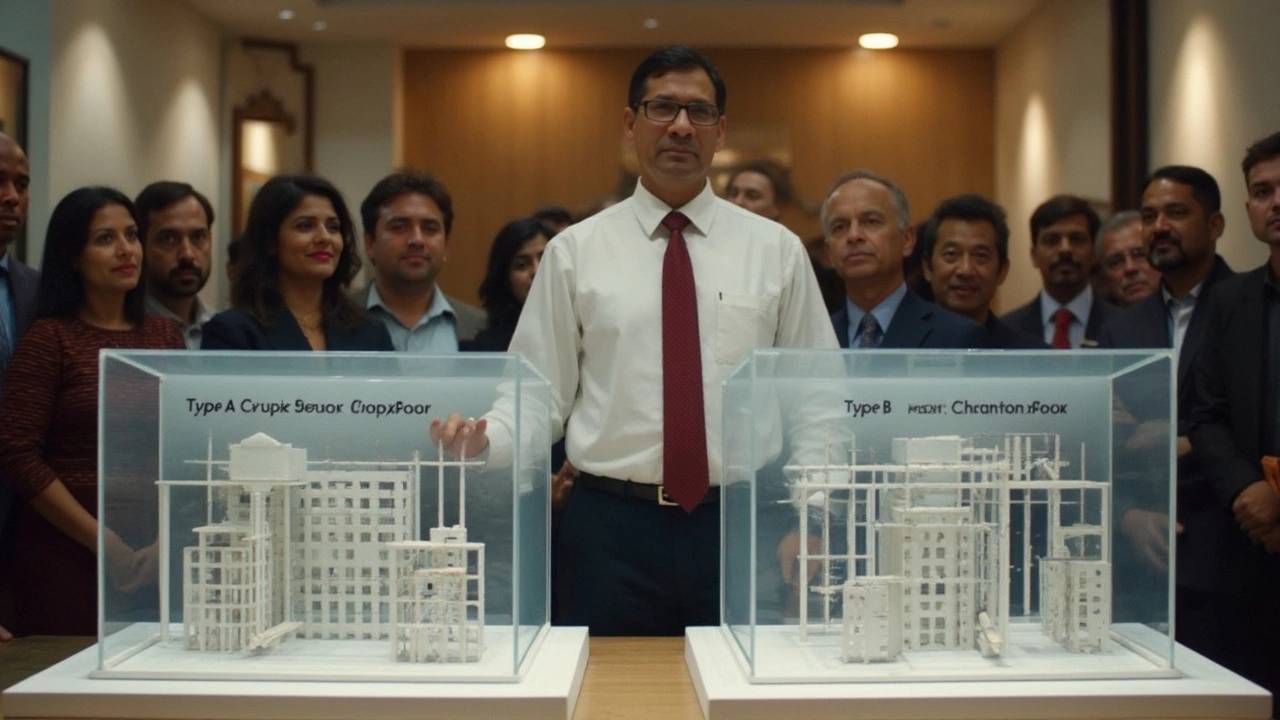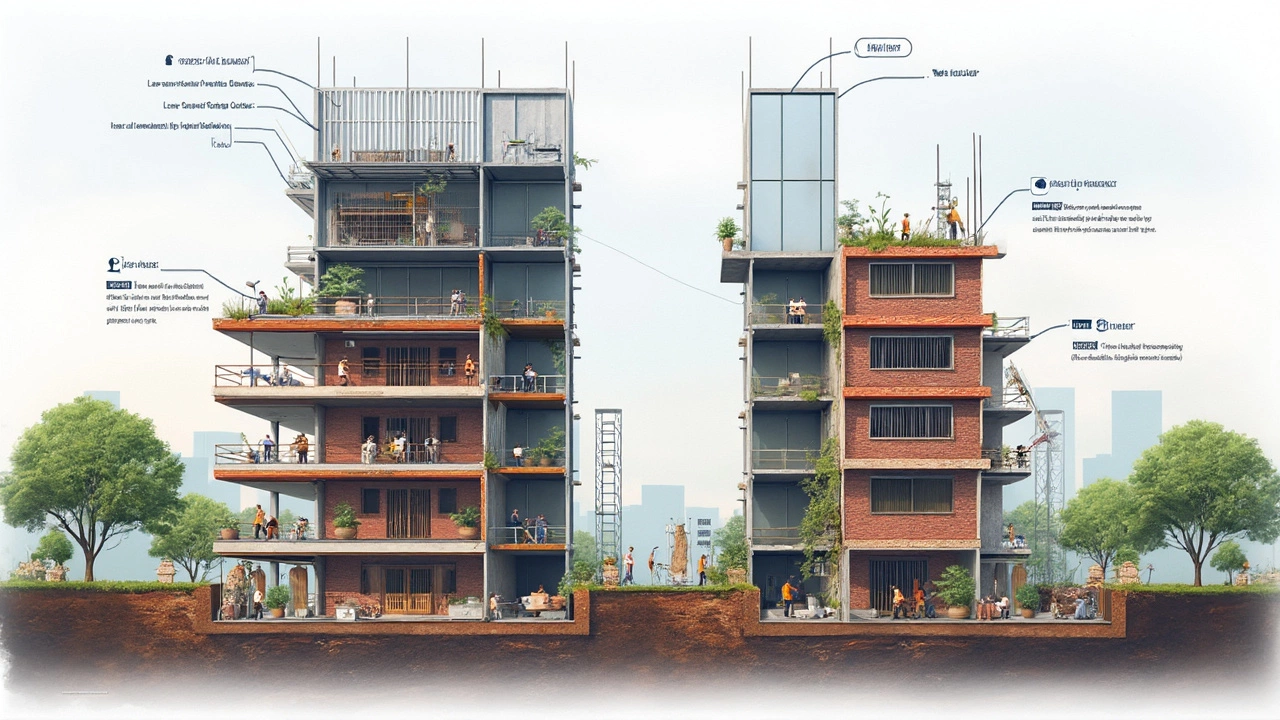Walk through any big city and you'll spot buildings that look sturdy enough to survive just about anything. Ever wonder what goes into making a commercial building safe? A big part of the answer boils down to two words: type A and type B construction. These aren’t just labels for paperwork—they shape exactly how a building handles disaster, from fires to earthquakes. Mess this up, and you risk lives and money.
When city inspectors show up, they care deeply about what “type” your building is. Why? Because the type sets strict rules about materials and maximum heights, and it spells out how long parts of the building should last in a fire. Choosing the wrong type can mean failed inspections, more costs, or even being forced to rebuild.
- Type A Construction: The Basics and Why It Exists
- Type B Construction: How It Differs and Where It Fits
- Choosing the Right Type for Your Project
- Real-World Scenarios and Expert Tips
Type A Construction: The Basics and Why It Exists
If you’re looking at the top shelf when it comes to type A construction, you’re talking about buildings built for max fire protection. Type A is often called “protected construction,” which basically means it’s designed to buy people time in an emergency and prevent collapse as long as possible. Think of big offices, hospitals, or new high-rise apartments—the kind you’d want to feel safe in even if something goes wrong.
What really makes type A stand out is the materials and extra safety features. Every structural part—columns, floors, even the roof—needs a tough fire-resistance rating. For commercial buildings, that often means at least two to three hours before a fire can break through something like a concrete wall or steel beam wrapped in fireproof coating.
- Structural frame (columns and beams): Usually requires a rating of two hours or more.
- Floors and roofs: Must hold up for at least two hours, sometimes longer depending on height or size.
- Walls and partitions: Also beefed up, with non-combustible materials like masonry or fireproofed steel.
The reason this all exists? Cities want to keep people safe in packed, tall commercial buildings where evacuation isn’t quick. Firefighters get precious extra time to do their job, reducing property damage too.
Here’s a quick look at standard fire-resistance times you’ll see for type A:
| Building Element | Fire Resistance (hours) |
|---|---|
| Main structure | 2-3 |
| Floors | 2 |
| External walls | 2-3 |
These rules are why you see type A in airports, shopping malls, and busy office towers. The higher you go or the more people you fit inside, the more likely it is that type A construction isn’t just preferred—it’s required by building codes in most cities.
Type B Construction: How It Differs and Where It Fits
When someone drops the phrase type B construction, they’re talking about a style that’s more relaxed on fire and material rules compared to type A construction. In plain English: type B buildings have less strict requirements for things like walls, floors, and beams when it comes to holding up in a fire. You’ll usually find these buildings in places where high fire resistance isn’t as critical, like small offices, low-rise retail, restaurants, and even some schools.
The heart of type B construction is cost-effectiveness and flexibility. Builders can use lighter materials, and there’s a bit more wiggle room on how long parts of the building can handle a fire before they fail. For example, in the International Building Code (IBC), a type B structure typically only has to stand up to fire for one hour, while type A often asks for two or even three. That difference saves a ton on both materials and labor, which is why a lot of developers love it for projects that don’t call for fortress-level toughness.
- Type B construction often means less concrete, more wood or metal studs—making the building lighter and cheaper to put up.
- It's best for places that aren't packed with people 24/7 or where folks can get out fast if there’s ever a fire.
- Because the rules are looser, buildings can go up quicker, which is a win for tight schedules and tight budgets.
But there’s a catch. Local codes may limit how tall or wide you can build using type B construction, and insurance companies keep a close eye on these choices. For example—a quick comparison:
| Feature | Type B Construction | Type A Construction |
|---|---|---|
| Minimum Fire Rating | 1 hour | 2-3 hours |
| Materials Allowed | Wood, steel, lighter concrete | Heavier, more fireproof materials |
| Building Height/Area | Usually smaller/lower | Can go higher/larger |
Long story short: if you’re building a strip mall or a mid-sized office and your top priority is managing costs while meeting code, type B construction could be all you need. Just don’t try it for something like a hospital or a high-rise hotel—those are jobs for type A construction every time.

Choosing the Right Type for Your Project
Picking between type A construction and type B construction doesn’t start with flipping a coin. You have to lock in three main things: what the building’s for, where it’s going up, and how many people will use it. Get any of these wrong and you’ll have headaches with permits—or worse, safety gaps you didn’t see coming.
Type A is usually for places with a lot of people or expensive stuff—think medical centers, office towers, or malls. That’s because it focuses on extra fire resistance. The walls, beams, and floors are beefed up so they can handle longer exposure to flames and let people get out safely. For example, type A often means two to three hours of fire resistance for structural elements, which could save lives in a huge emergency. Codes in cities like New York or San Francisco push type A hard for taller or denser builds.
Type B is more common in smaller, lower-risk commercial jobs. If you’re working on a strip mall or a standalone fast food shop, type B might do the trick. It doesn’t have quite the same fire rating for the guts of the building. It’s faster and usually cheaper, but it has limits on how high or how big you can go.
Feel stuck? Try this quick checklist:
- Check the planned use of the building—assembly, office, healthcare, retail, storage—all have different requirements.
- Look up your city’s fire safety and building height codes. These are deal-breakers for commercial building projects.
- Weigh cost versus safety. Type A will cost more upfront, but insurance may run lower and tenant safety will be higher.
- Ask what your insurer needs. Some won’t even cover certain building heights unless you go with type A.
If you like numbers, here’s a simple way to spot the difference:
| Type | Fire Resistance (major parts) | Typical Max Height (stories) |
|---|---|---|
| Type A | 2-3 hours | Up to 12 |
| Type B | 1 hour | Up to 5 |
No matter what you pick, loop in your architect and code consultant early. I’ve seen projects stall for months because someone guessed wrong on the building type during design. And let’s be real—no one wants to explain that to the investors.
Real-World Scenarios and Expert Tips
Let’s get hands-on. Say you’re planning a new office building in downtown. The city tells you it’s going to be over five stories. Right away, you have to look at type A construction. Why? Fire codes for tall commercial buildings are strict—steel columns might need two hours of fire resistance. Builders might use concrete-encased steel instead of just standard steel beams. Think about how quickly a fire can move: type A can give you double the evacuation time compared to a typical type B.
I’ve seen retail plaza owners try to save money by pushing for type B construction when it really didn’t fit the project. The city shut things down after just one inspection. They didn’t have enough fire separation between stores, and the structural frame wasn’t rated long enough for fires. It’s hundreds of thousands of dollars just to redo the mistakes.
Not sure what to choose? Check with your local authority early—don’t wait until after signing the lease or pouring concrete. Every city is different, and code changes often. You’d be surprised how a single material—like switching from wood framing to steel—bumps you from type B to type A requirements.
Here’s a snapshot to see where you usually find each type, so you don’t get caught out:
| Building Type | Common Use | Max Height (General) | Fire Resistance (Typical) |
|---|---|---|---|
| Type A | High-rises, hospitals, major offices | Unlimited (depends on code) | 2-3 hours |
| Type B | Strip malls, low-rise offices, small shops | Up to 2-3 stories | 1 hour |
Here are a few tips from contractors and building inspectors I trust:
- If your project’s budget is tight, don’t skip the code study phase. Some projects have eaten up their savings in the first few months because they guessed wrong on construction type.
- Insure with the actual type you build. Insurance companies have gotten picky—if you claim it’s type A when it’s really type B, expect trouble if you ever file a claim.
- Check for future-proofing. If you think you’ll add floors or expand, go for type A construction from the start. Upgrading later can cost more than just doing it right the first time.
- Don’t just rely on the architect’s word. Double-check how engineers and inspectors define type A construction and type B construction in your area. Local tweaks can be a deal-breaker.
Messed up on the type? Get ahead by talking to your building department as soon as possible. Fixes are cheaper before anyone steps onsite. With the right prep, you’ll avoid expensive headaches and keep everyone safe—whether that’s your tenants, your investment, or your peace of mind.

Written by Fletcher Abernathy
View all posts by: Fletcher Abernathy